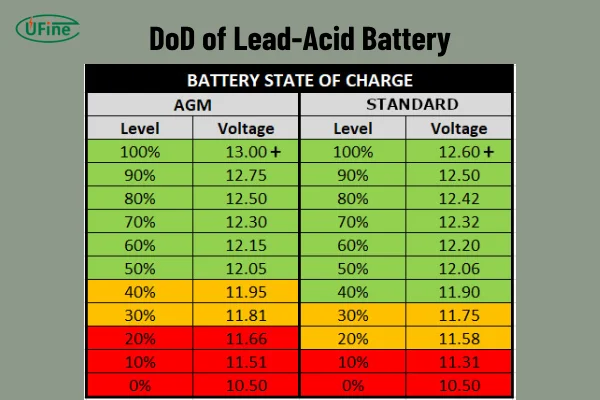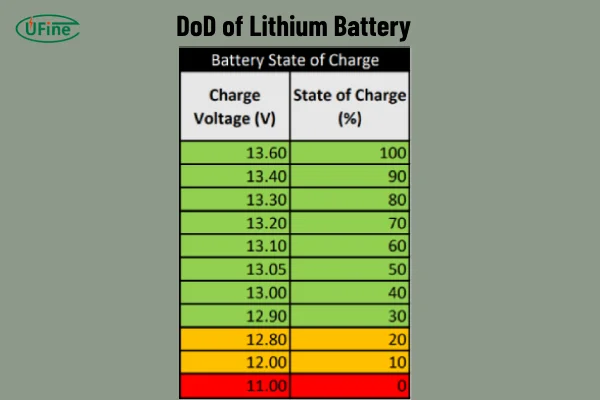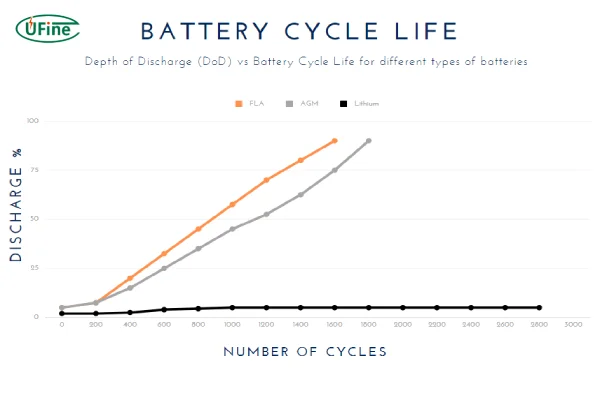If you’ve ever experienced your phone dying too quickly or noticed that your battery doesn’t hold a charge like it used to, you may have heard the term Battery DoD—or Depth of Discharge. It’s a critical concept when it comes to the health and longevity of your devices’ batteries, but not everyone knows exactly what it means. In this article, we’ll explore what Battery DoD is, how deep discharge affects battery life, and how you can manage it to ensure your battery stays strong and efficient for as long as possible. Let’s dive in.
Part 1. What does battery DoD mean?
At its core, Battery DoD (Depth of Discharge) refers to how much of a battery’s energy has been drained, expressed as a percentage. To understand this better, imagine a battery with 100% charge. If it’s used until it reaches 50%, the DoD is 50%. Essentially, it tells you how much energy has been used and how much is left.
For instance, if you’re using a smartphone, and your battery drops from 100% to 50%, the DoD would be 50%. But it’s important to know that higher DoD values, meaning deeper discharges, tend to shorten the battery’s lifespan. This is because the more you discharge the battery, the harder it works, which leads to a faster degradation of its internal components.
Why Battery Degradation Happens and Its Impact
Part 2. The effect of deep discharge on the battery
Deep discharge—draining a battery to low levels—can severely affect its performance. Let’s talk about the negative effects deep discharge has on batteries, especially lithium-ion, which are the most common type found in smartphones, laptops, and electric vehicles.
-
Loss of Capacity: When a battery is deeply discharged repeatedly, its internal structure undergoes chemical changes that reduce its capacity. Over time, it simply can’t hold a charge as well as it used to, which means fewer hours of use between charges. It’s similar to running a marathon every day without proper rest—you’ll wear out faster.
-
Internal Damage and Over-Discharge: When the battery voltage drops too low (typically below 2.5V for lithium-ion batteries), it can cause permanent damage. This is because the electrochemical reactions inside the battery start to break down, and the battery can no longer function properly. Some batteries may even become completely unchargeable after deep discharge, especially if the voltage falls below a critical threshold.
-
Increased Heat Generation: Deep discharge can increase the likelihood of overcharging once the battery is plugged back in to recharge. If the charger continuously tries to force power back into a deeply discharged battery, it may overheat, causing safety risks like battery swelling or leakage.
-
Higher Internal Resistance: As a battery ages or goes through deep discharge cycles, the internal resistance increases. This means that when charging or discharging, the battery faces more resistance to the flow of energy, leading to less efficient performance. Essentially, the battery works harder, consumes more energy, and loses charge more quickly.
In short, deep discharging your battery isn’t just bad for its performance—it can permanently reduce its ability to store energy. The next section will help you understand how different types of batteries handle deep discharge differently, so let’s explore that in more detail.
Part 3. DoD of different types of batteries
Not all batteries are created equal when it comes to handling deep discharge. Depending on the chemistry and design, each type has different tolerances for deep discharges. Here’s a breakdown of how various batteries perform under such stress:
-
Lithium-Ion Battery: These are the most common batteries in modern devices. They’re designed to withstand deep discharges better than many other battery types. However, they still suffer from capacity loss when deeply discharged repeatedly. Most lithium-ion batteries are rated for a 20-80% DoD. While they can handle some deep discharge (e.g., going down to 20% or lower), consistently draining them to 0% can shorten their lifespan and cause irreversible damage.
-
Lead-Acid Battery: Commonly used in vehicles and backup power systems, lead-acid batteries have a much lower tolerance for deep discharge. For optimal lifespan, lead-acid batteries should not be discharged below 50% DoD. Regular deep discharge can lead to permanent damage, including sulfation (build-up of lead sulfate), which hampers the battery’s ability to charge properly.
-
Nickel-Metal Hydride (NiMH) Battery: NiMH batteries, used in older devices and rechargeable power tools, typically handle deep discharge better than lead-acid batteries but not as well as lithium-ion. For best performance, avoid discharging them below 50% of their total capacity. Consistent deep discharge will reduce their efficiency and shorten their life.
Understanding the DoD tolerance for each battery type is essential for prolonging battery life. Knowing this helps you avoid causing unnecessary harm to the battery by over-discharging it.
Part 4. Battery discharge depth and cycle life
The depth of discharge (DoD) has a direct and significant impact on the cycle life of a battery. To put it simply, cycle life refers to the number of complete charge and discharge cycles a battery can undergo before its capacity diminishes to a certain point, typically 80% of its original capacity. The deeper the discharge, the fewer cycles the battery will last, and the shorter its overall lifespan will be. Let’s break down the relationship between discharge depth and cycle life in more detail.
1. Shallow Discharges = Longer Cycle Life
Batteries are designed to undergo a certain number of charge cycles, but how deep those cycles go makes a difference. If you frequently charge and discharge a battery from 100% down to 50%, it undergoes a shallow discharge cycle. A shallow cycle means less stress on the battery’s internal components. This leads to less wear and tear, allowing the battery to endure more cycles before it starts losing its capacity.
For example, a lithium-ion battery that is discharged to 50% and then recharged to full can usually undergo several thousand cycles before it needs replacing. The deeper the discharge, the fewer cycles the battery will last. This is why many manufacturers recommend keeping your battery charge between 20-80% to maximize its longevity.
2. Deeper Discharges = Shorter Cycle Life
On the flip side, deeper discharges—where the battery is drained to very low levels, often near 0%—result in a reduction of cycle life. A battery that is discharged from 100% to 0% is undergoing what’s known as a deep cycle. While deep cycles are necessary for certain applications (like in electric vehicles or solar power storage), they take a greater toll on the battery.
A deep discharge cycle can cause chemical degradation and structural changes within the battery, which accelerates its aging process. For example, a battery that regularly undergoes deep discharges may only last 300-500 cycles before it loses significant capacity, compared to the thousands of cycles it could provide with shallow discharges. This shorter cycle life is often the trade-off when a battery is used in devices that require large amounts of energy over a longer period, such as in electric cars or power tools.
3. The Importance of Moderate Discharges
To optimize your battery’s cycle life, it’s ideal to aim for a moderate discharge depth, avoiding extremes. For lithium-ion batteries, staying within the 30-70% DoD range is often recommended. This strategy allows for longer-lasting performance without placing excessive strain on the battery’s internal components.
Additionally, partial discharges tend to reduce the rate of degradation. Batteries don’t have memory effects like older nickel-based batteries, so they don’t need to be fully drained before recharging. It’s better to charge them more frequently but in smaller amounts to keep them in an optimal state.
4. Energy Demanding Applications and Trade-offs
It’s important to note that in certain high-energy applications, such as in electric vehicles (EVs) or solar power storage systems, deep discharges are sometimes unavoidable due to the high energy demands. In these cases, manufacturers design deep cycle batteries to handle deeper discharges without significantly affecting their longevity. These batteries are built to withstand the stresses of deep cycling, and often come with advanced battery management systems (BMS) that protect the battery from damage during high usage.
However, even deep cycle batteries experience capacity loss over time, and frequent deep discharges will still reduce their overall lifespan. Therefore, even in demanding applications, careful monitoring of discharge depth is crucial to balance performance and longevity.
Part 5. Deep discharge battery vs. deep cycle battery
You may have heard the terms deep discharge battery and deep cycle battery. It’s easy to confuse the two, but they refer to very different concepts:
-
Deep Discharge Battery: This refers to a battery that has been discharged beyond its recommended limit, which causes harm to its performance and lifespan. Deep discharging a regular battery (e.g., lithium-ion, NiMH) puts excessive stress on it, and over time, it won’t hold charge as well.
-
Deep Cycle Battery: A deep cycle battery is designed to be discharged and recharged repeatedly. Unlike standard batteries, deep cycle batteries can handle repeated deep discharges without damaging the internal components. They are built to supply steady power over a long period, and they are typically used in off-grid solar power systems, electric vehicles, and marine applications.
12V Deep Discharge Batteries: A Simple Overview
In summary, deep cycle batteries are made for deep discharges, while regular batteries (like those in your phone or laptop) aren’t. This is why you should be careful about how deeply you discharge the batteries in your everyday devices.
Part 6. How to avoid deep discharge of batteries?
Avoiding deep discharge is one of the best ways to prolong the life of your battery. Here are a few practical tips to help you prevent damage from deep discharging:
-
Charge Early, Charge Often: Instead of waiting for your battery to dip into the 20% or lower range, plug it in when it hits around 30-40%. This ensures you never push the battery into a deep discharge state, while also keeping it in its optimal charging range.
-
Use Battery Management Systems: Many modern devices come with built-in battery management systems that monitor and control the depth of discharge to protect the battery from harm. If your device allows for it, activate battery saver mode or set up low-battery warnings so you never accidentally over-discharge.
-
Avoid Overnight Charging: While it’s convenient to charge overnight, this can lead to the battery being constantly charged or deeply discharged if the charger isn’t designed to stop at 100%. Make sure you use a charger with overcharge protection or charge during the day when you can unplug it once it reaches 100%.
-
Keep Track of Battery Usage: If you use rechargeable batteries for tools, power banks, or even in your electric vehicle, keep an eye on when they last charged and avoid running them down to 0%. Regularly check the battery status and avoid using it until it’s completely drained.
By taking these steps, you can minimize the risk of deep discharge and extend the overall lifespan of your battery.
Part 7. How to repair a deep discharge battery?
If your battery has already suffered from deep discharge, there’s hope for repair—at least, in some cases. Here are some ways to attempt to restore a deeply discharged battery:
-
Use a Slow Charger: For lithium-ion batteries, you can attempt to use a slow charger, which charges the battery at a lower current. This method might help revive a deeply discharged battery by slowly reintroducing energy and getting the internal components back into action.
-
Desulfation for Lead-Acid Batteries: For lead-acid batteries, a process called desulfation can be used. This method involves sending a high-frequency pulse through the battery to break down the lead sulfate that may have built up during deep discharge. Specialized chargers designed for desulfation are available and can help restore some capacity.
-
Battery Reconditioning: There are battery reconditioning tools available that can cycle the battery between charging and discharging to help restore its capacity. However, this is more effective for batteries that haven’t been damaged too severely by deep discharge.
It’s important to note that not all batteries can be repaired after deep discharge, especially lithium-ion batteries. Sometimes, if the damage is severe, replacing the battery is the only solution.
Part 8. Conclusion
Battery DoD is more than just a number. It’s a vital factor in maintaining the health of your devices’ batteries. By understanding the impact of deep discharge, knowing the limits of your battery type, and taking steps to avoid and repair damage, you can ensure your batteries last longer and perform better. The key takeaway? Treat your batteries with care, and they’ll reward you with longer, more reliable use.
By following these guidelines, you’ll not only protect your devices but also save money in the long run by reducing the need for battery replacements. So, the next time you charge your phone, laptop, or car, remember the importance of Battery DoD—and keep your devices running at their best!
Read More
Learn About Lithium Battery Electrolyte
Learn About Lithium Battery Protective Board
What Does Depth of Discharge Mean?
Voltage vs Current: What is the Difference?
Related Tags:
More Articles

Small LiFePO4 Batteries for Solar Garden Lights: What to Look For
Learn why small LiFePO4 batteries are ideal for solar garden lights with tips on features, benefits, and how to choose the best one.
How to Choose the Right Small LiFePO4 Battery: Capacity, Dimensions, and Price
Learn how to choose the right small LiFePO4 battery by comparing capacity, size, and price for solar, RVs, scooters, and backup power needs.
Laptop Battery Replacement Guide – How to Choose Safely
Need a new laptop battery? Learn when to replace it, how to choose the right one, and where to buy safe replacements. Tips included!
What Is the Smallest 12V Battery? A Comparison of Mini Lithium Options
Discover the smallest 12V lithium batteries with top picks, comparisons, and tips for compact, powerful, and reliable energy solutions.
Current Draw and Discharge Rates: Optimizing Amped Lithium Battery Performance
Optimize Amped lithium battery life by managing current draw and discharge rates for better performance, faster charging, and longer lifespan.






